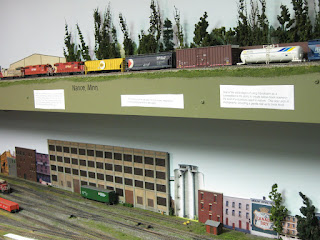
Signs on the Manitoba & Minnesota Sub.
“Sign, sign, everywhere a sign.” That’s what the Canadian group Five Man Electrical Band sang in their big hit in 1971.
There are also signs everywhere on the CP Rail Manitoba & Minnesota Subdivision. But, unlike in the song, my songs aren’t “blocking out the scenery” or “breaking my mind.” My signs do the opposite—they inform and, hopefully, enlighten visitors.
One thing I have found during layout tours is that a) I can’t keep an eye on the trains and answer everyone’s questions when there are so many people in the room and b) I have to answer the same questions over and over again. (How did you make your trees? What is the height of your levels? How did you make those rocks?”)
I like talking to people, but I just can’t keep up. That’s where the signs come in.
Prior to a layout tour, like the one happening May 30 during the NMRA Thousand Lakes Region convention here in Winnipeg, I tape signs to the fascia around the layout. The signs tell people about scenery techniques, how I made buildings, what's behind those windows, the length of the mainline run, the concept behind the layout, how to find a mirror, etc.
It’s a simple and easy way to help people get the information they need—and keep me from going crazy.
Like a work of art, a layout is supposed to speak for itself. With all my signs, the M & M Sub. really does!

Another sign on the layout.






